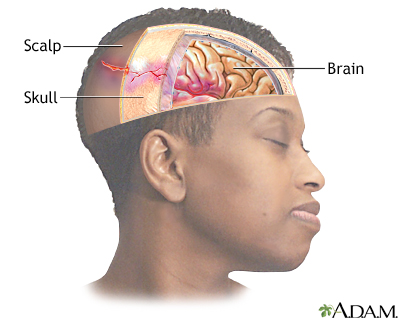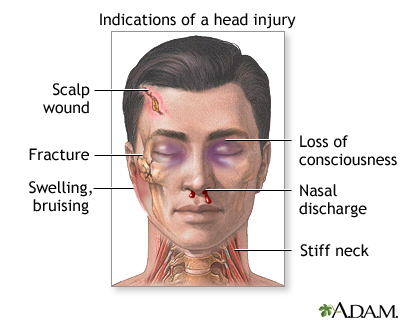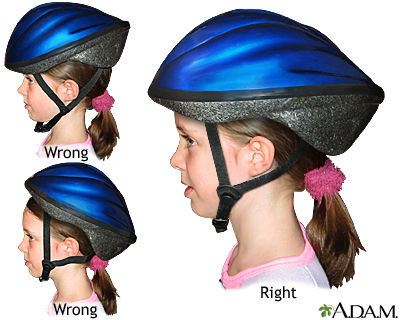what to watch for after a head injury
A head injury is whatsoever trauma to the scalp, skull, or brain. The injury may exist only a minor bump on the skull or a serious brain injury.

Caput injury can be either closed or open (penetrating).
- A closed caput injury ways you received a hard blow to the head from hitting an object, but the object did not intermission the skull.
- An open up, or penetrating, caput injury means you were hit with an object that broke the skull and entered the brain. This is more likely to happen when you move at high speed, such as going through the windshield during a auto accident. It can too happen from a gunshot to the head.
Head injuries include:
- Concussion, in which the brain is shaken, is the nearly common type of traumatic brain injury.
- Scalp wounds.
- Skull fractures.
Head injuries may cause bleeding:
- In the brain tissue
- In the layers that environment the encephalon (subarachnoid hemorrhage, subdural hematoma, extradural hematoma)
Head injury is a common reason for an emergency room visit. A large number of people who suffer head injuries are children. Traumatic encephalon injury (TBI) accounts for over 1 in 6 injury-related hospital admissions each yr.
Common causes of head injury include:
- Accidents at habitation, work, outdoors, or while playing sports
- Falls
- Physical set on
- Traffic accidents
Most of these injuries are modest because the skull protects the brain. Some injuries are severe enough to crave a stay in the hospital.
Head injuries may crusade bleeding in the brain tissue and the layers that surroundings the brain (subarachnoid hemorrhage, subdural hematoma, epidural hematoma).
Symptoms of a head injury can occur right away or may develop slowly over several hours or days. Even if the skull is non fractured, the brain tin can hit the inside of the skull and be bruised. The head may look fine, but issues could result from haemorrhage or swelling inside the skull.
The spinal cord is also likely to be injured from falls from a significant height or ejection from a vehicle.
Some head injuries cause changes in brain function. This is called a traumatic brain injury. Concussion is a traumatic brain injury. Symptoms of a concussion can range from balmy to severe.
Learning to recognize a serious head injury and give basic first assist tin save someone'southward life. For a moderate to astringent caput injury, CALL 911 RIGHT Away.
Get medical help right abroad if the person:
- Becomes very sleepy
- Behaves abnormally, or has speech that does non make sense
- Develops a severe headache or stiff cervix
- Has a seizure
- Has pupils (the dark primal function of the eye) of unequal sizes
- Is unable to move an arm or leg
- Loses consciousness, even briefly
- Vomits more than than in one case

Then take the following steps:
- Check the person's airway, breathing, and circulation. If necessary, begin rescue breathing and CPR.
- If the person's breathing and heart rate are normal, but the person is unconscious, treat as if there is a spinal injury. Stabilize the head and neck by placing your easily on both sides of the person's caput. Go along the caput in line with the spine and forbid movement. Wait for medical help.
- Stop any bleeding by firmly pressing a clean fabric on the wound. If the injury is serious, be careful not to motility the person'due south head. If claret soaks through the cloth, exercise not remove it. Place another cloth over the first one.
- If you suspect a skull fracture, practice not apply directly pressure to the bleeding site, and do not remove whatsoever droppings from the wound. Comprehend the wound with sterile gauze dressing.
- If the person is vomiting, to prevent choking, roll the person's head, neck, and body every bit one unit onto their side. This nevertheless protects the spine, which you must always assume is injured in the case of a caput injury. Children often vomit once later a caput injury. This may not be a trouble, but phone call a doc for further guidance.
- Apply ice packs to bloated areas (comprehend ice in a towel so it does not directly touch the peel).
Follow these precautions:
- Do NOT wash a head wound that is deep or haemorrhage a lot.
- Practise Non remove any object sticking out of a wound.
- Practice NOT move the person unless absolutely necessary.
- DO Non shake the person if they seem mazed.
- Do Non remove a helmet if y'all doubtable a serious caput injury.
- DO Not option up a fallen kid with any sign of head injury.
- Exercise NOT drinkable booze within 48 hours of a serious head injury.
A serious head injury that involves haemorrhage or brain damage must be treated in a hospital.
For a mild caput injury, no treatment may exist needed. However, call for medical advice and watch for symptoms of a head injury, which can evidence upward afterward.
Your health care provider will explicate what to look, how to manage any headaches, how to treat your other symptoms, when to render to sports, schoolhouse, work, and other activities, and signs or symptoms to worry most.
- Children will need to exist watched and make activity changes.
- Adults also demand close observation and activity changes.
Both adults and children must follow the provider's instructions near when information technology will be possible to return to sports.
Phone call 911 correct away if:
- There is severe head or face up bleeding.
- The person is confused, tired, or unconscious.
- The person stops breathing.
- Y'all doubtable a serious head or neck injury, or the person develops whatever signs or symptoms of a serious head injury.
Not all caput injuries tin be prevented. The following simple steps can assist keep you lot and your child safe:
- Always use safety equipment during activities that could cause a head injury. These include seat belts, wheel or motorbike helmets, and hard hats.
- Learn and follow bicycle safety recommendations.
- Practise not drink and drive, and do not permit yourself to be driven by someone who you know or suspect has been drinking alcohol or is impaired in some other way.

Brain injury; Head trauma
Hockenberry B, Pusateri K, McGrew C. Sports-related head injuries. In: Kellerman RD, Rakel DP, eds. Conn's Current Therapy 2020. Philadelphia, PA: Elsevier 2020:693-697.
Hudgins East, Grady Due south. Initial resuscitation, prehospital care, and emergency room intendance in traumatic brain injury. In: Winn HR, ed. Youmans and Winn Neurological Surgery. 7th ed. Philadelphia, PA: Elsevier; 2017:chap 348.
Papa L, Goldberg SA. Head trauma. In: Walls RM, Hockberger RS, Gausche-Hill M, eds. Rosen's Emergency Medicine: Concepts and Clinical Practice. 9th ed. Philadelphia, PA: Elsevier; 2018:chap 34.
Updated by: Jacob L. Heller, MD, MHA, Emergency Medicine, Emeritus, Virginia Mason Medical Eye, Seattle, WA. Too reviewed past David Zieve, MD, MHA, Medical Director, Brenda Conaway, Editorial Director, and the A.D.A.M. Editorial team.
Source: https://medlineplus.gov/ency/article/000028.htm
0 Response to "what to watch for after a head injury"
Post a Comment